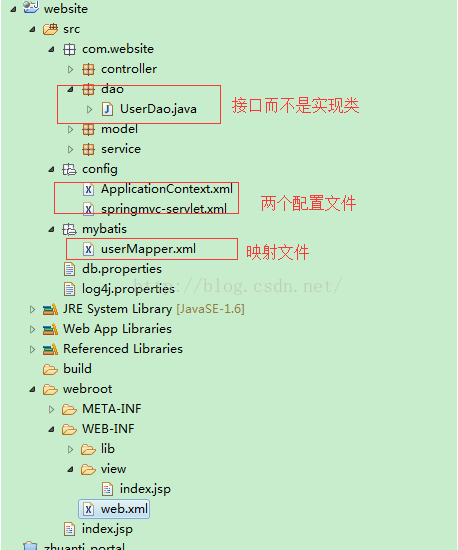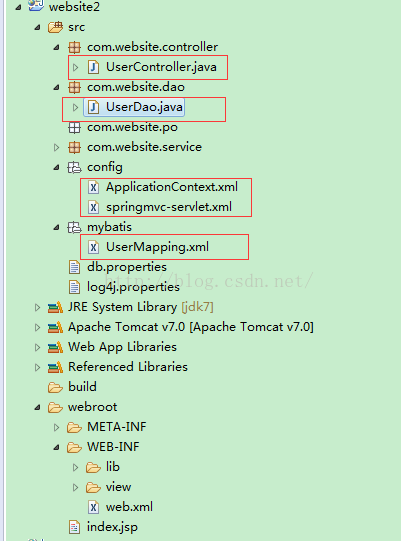在之前的文章中总结了三种方式,但是有两种是注解sql的,这种方式比较混乱所以大家不怎么使用,下面总结一下常用的两种总结方式:
一、 动态代理实现 不用写dao的实现类
这种方式比较简单,不用实现dao层,只需要定义接口就可以了,这里只是为了记录配置文件所以程序写的很简单:
1、整体结构图:

2、三个配置文件以及一个映射文件
(1)、程序入口以及前端控制器配置 web.xml
|
1
2
3
4
5
6
7
8
9
10
11
12
13
14
15
16
17
18
19
20
21
22
23
24
25
26
27
28
29
30
31
32
33
34
35
36
37
38
39
40
41
42
43
44
45
46
47
48
49
50
51
52
53
54
55
56
57
58
59
|
<?xml version="1.0" encoding="utf-8"?> <web-app xmlns:xsi="http://www.w3.org/2001/xmlschema-instance" xmlns="http://java.sun.com/xml/ns/javaee" xsi:schemalocation="http://java.sun.com/xml/ns/javaee http://java.sun.com/xml/ns/javaee/web-app_3_0.xsd" id="webapp_id" version="3.0"> <display-name>website1</display-name> <!-- 设置监听,在web容器启动时自动装配applicationcontext的配置信息--> <listener> </listener> <!-- 设置spring容器加载配置文件路径 --> <context-param> <param-name>contextconfiglocation</param-name> <param-value> classpath:config/springmvc-servlet.xml, classpath:config/applicationcontext.xml </param-value> </context-param> <!-- 字符编码过滤器 --> <filter> <filter-name>encodingfilter</filter-name> <filter-class>org.springframework.web.filter.characterencodingfilter</filter-class> <init-param> <param-name>encoding</param-name> <param-value>utf-8</param-value> </init-param> <init-param> <param-name>forceencoding</param-name> <param-value>true</param-value> </init-param> </filter> <filter-mapping> <filter-name>encodingfilter</filter-name> <url-pattern>*.do</url-pattern> </filter-mapping> <!-- 前端控制器 --> <servlet> <servlet-name>springmvc</servlet-name> <servlet-class>org.springframework.web.servlet.dispatcherservlet</servlet-class> <init-param> <param-name>contextconfiglocation</param-name> <param-value>classpath:config/springmvc-servlet.xml</param-value> </init-param> <!-- 这个配置文件在容器启动的时候 就加载 --> <load-on-startup>1</load-on-startup> </servlet> <servlet-mapping> <servlet-name>springmvc</servlet-name> <!-- 拦截请求 --> <url-pattern>*.do</url-pattern> </servlet-mapping> <welcome-file-list> <welcome-file>index.html</welcome-file> <welcome-file>index.htm</welcome-file> <welcome-file>index.jsp</welcome-file> <welcome-file>default.html</welcome-file> <welcome-file>default.htm</welcome-file> <welcome-file>default.jsp</welcome-file> </welcome-file-list> </web-app> |
(2)、扫描控制层、自动注入以及视图解析器的配置 springmvc-servlet.xml
|
1
2
3
4
5
6
7
8
9
10
11
12
13
14
15
16
17
18
19
20
21
22
23
24
25
26
27
28
|
<?xml version="1.0" encoding="utf-8"?> <beans xmlns="http://www.springframework.org/schema/beans" xmlns:xsi="http://www.w3.org/2001/xmlschema-instance" xmlns:aop="http://www.springframework.org/schema/aop" xmlns:context="http://www.springframework.org/schema/context" xmlns:mvc="http://www.springframework.org/schema/mvc" xmlns:util="http://www.springframework.org/schema/util" xmlns:tx="http://www.springframework.org/schema/tx" xmlns:jdbc="http://www.springframework.org/schema/jdbc" xmlns:cache="http://www.springframework.org/schema/cache" xsi:schemalocation=" http://www.springframework.org/schema/beans http://www.springframework.org/schema/beans/spring-beans-3.1.xsd http://www.springframework.org/schema/aop http://www.springframework.org/schema/aop/spring-aop-3.1.xsd http://www.springframework.org/schema/context http://www.springframework.org/schema/context/spring-context-3.1.xsd http://www.springframework.org/schema/mvc http://www.springframework.org/schema/mvc/spring-mvc-3.1.xsd http://www.springframework.org/schema/util http://www.springframework.org/schema/util/spring-util-3.1.xsd http://www.springframework.org/schema/tx http://www.springframework.org/schema/tx/spring-tx-3.1.xsd http://www.springframework.org/schema/jdbc http://www.springframework.org/schema/jdbc/spring-jdbc-3.1.xsd http://www.springframework.org/schema/cache http://www.springframework.org/schema/cache/spring-cache-3.1.xsd"> <!-- 注解驱动 --> <mvc:annotation-driven /> <!-- <context:annotation-config /> --> <!-- context:component-scan 具有annotation-config 的功能 --> <!-- 扫描 控制层 --> <context:component-scan base-package="com.website.controller"></context:component-scan> <!-- 视图解析器 --> <bean id="viewresolver" class="org.springframework.web.servlet.view.internalresourceviewresolver"> <property name="prefix" value="/web-inf/view/"> </property> <property name="suffix" value=".jsp"></property> </bean> </beans> |
(3)、数据源、service 自动扫描注入、spring代管mybatissqlsessionfactory 、dao层接口动态代理以及事务的配置applicationcontext.xml
这里会有多中配置文件
1)、单数据源,动态代理实现dao层接口时不设置sqlsessionfactorybeanname、或sqlsessiontemplatebeanname 两个属性的值
|
1
2
3
4
5
6
7
8
9
10
11
12
13
14
15
16
17
18
19
20
21
22
23
24
25
26
27
28
29
30
31
32
33
34
35
36
37
38
39
40
41
42
43
44
45
46
47
48
49
50
51
52
53
54
55
|
<?xml version="1.0" encoding="utf-8"?> <beans xmlns="http://www.springframework.org/schema/beans" xmlns:xsi="http://www.w3.org/2001/xmlschema-instance" xmlns:tx="http://www.springframework.org/schema/tx" xmlns:context="http://www.springframework.org/schema/context" xsi:schemalocation="http://www.springframework.org/schema/beans http://www.springframework.org/schema/beans/spring-beans-3.2.xsd http://www.springframework.org/schema/context http://www.springframework.org/schema/context/spring-context-3.2.xsd http://www.springframework.org/schema/tx http://www.springframework.org/schema/tx/spring-tx-3.2.xsd"> <!-- 加载配置jdbc文件 --> <context:property-placeholder location="classpath:db.properties" /> <!-- 数据源 --> <bean id="datasource" class="org.springframework.jdbc.datasource.drivermanagerdatasource"> <property name="driverclassname"> <value>${jdbc.driverclassname}</value> </property> <property name="url"> <value>${jdbc.url}</value> </property> <property name="username"> <value>${jdbc.username}</value> </property> <property name="password"> <value>${jdbc.password}</value> </property> </bean> <!-- 开启注解配置 即autowried --> <!-- <context:annotation-config/> --> <!--其实component-scan 就有了annotation-config的功能即把需要的类注册到了spring容器中 --> <context:component-scan base-package="com.website.service" /> <!-- 在使用mybatis时 spring使用sqlsessionfactorybean 来管理mybatis的sqlsessionfactory --> <bean id="sqlsessionfactory" class="org.mybatis.spring.sqlsessionfactorybean"> <property name="datasource" ref="datasource" /> <!-- mybatis配置文件路径 --> <property name="configlocation" value="" /> <!-- 实体类映射文件路径,这里只有一个就写死了,多个可以使用mybatis/*.xml来替代 --> <property name="mapperlocations" value="classpath:mybatis/usermapper.xml" /> </bean> <!-- <bean id="sqlsession" class="org.mybatis.spring.sqlsessiontemplate"> <constructor-arg index="0"> <ref bean="sqlsessionfactory"/> </constructor-arg> </bean> --> <!--动态代理实现 不用写dao的实现 --> <bean id="mapperscannerconfigurer" class="org.mybatis.spring.mapper.mapperscannerconfigurer"> <!-- 这里的basepackage 指定了dao层接口路劲,这里的dao接口不用自己实现 --> <property name="basepackage" value="com.website.dao" /> <!-- 如果只有一个数据源的话可以不用指定,但是如果有多个数据源的话必须要指定 --> <!-- <property name="sqlsessionfactorybeanname" value="sqlsessionfactory" /> --> <!--直接指定了sqlsessiontemplate名称,这个和上面的其实是一样的 --> <!-- <property name="sqlsessiontemplatebeanname" value="sqlsession" /> --> </bean> <!--事务管理器 --> <bean id="transactionmanager" class="org.springframework.jdbc.datasource.datasourcetransactionmanager"> <property name="datasource" ref="datasource" /> </bean> <!-- 使用全注释事务 --> <tx:annotation-driven transaction-manager="transactionmanager" /> </beans> |
2)、单数据源配置 sqlsessionfactorybeanname 这个属性值
|
1
2
3
4
5
6
7
8
9
10
11
12
13
14
15
16
17
18
19
20
21
22
23
24
25
26
27
28
29
30
31
32
33
34
35
36
37
38
39
40
41
42
43
44
45
46
47
48
49
50
51
52
53
54
55
|
<?xml version="1.0" encoding="utf-8"?> <beans xmlns="http://www.springframework.org/schema/beans" xmlns:xsi="http://www.w3.org/2001/xmlschema-instance" xmlns:tx="http://www.springframework.org/schema/tx" xmlns:context="http://www.springframework.org/schema/context" xsi:schemalocation="http://www.springframework.org/schema/beans http://www.springframework.org/schema/beans/spring-beans-3.2.xsd http://www.springframework.org/schema/context http://www.springframework.org/schema/context/spring-context-3.2.xsd http://www.springframework.org/schema/tx http://www.springframework.org/schema/tx/spring-tx-3.2.xsd"> <!-- 加载配置jdbc文件 --> <context:property-placeholder location="classpath:db.properties" /> <!-- 数据源 --> <bean id="datasource" class="org.springframework.jdbc.datasource.drivermanagerdatasource"> <property name="driverclassname"> <value>${jdbc.driverclassname}</value> </property> <property name="url"> <value>${jdbc.url}</value> </property> <property name="username"> <value>${jdbc.username}</value> </property> <property name="password"> <value>${jdbc.password}</value> </property> </bean> <!-- 开启注解配置 即autowried --> <!-- <context:annotation-config/> --> <!--其实component-scan 就有了annotation-config的功能即把需要的类注册到了spring容器中 --> <context:component-scan base-package="com.website.service" /> <!-- 在使用mybatis时 spring使用sqlsessionfactorybean 来管理mybatis的sqlsessionfactory --> <bean id="sqlsessionfactory" class="org.mybatis.spring.sqlsessionfactorybean"> <property name="datasource" ref="datasource" /> <!-- mybatis配置文件路径 --> <property name="configlocation" value="" /> <!-- 实体类映射文件路径,这里只有一个就写死了,多个可以使用mybatis/*.xml来替代 --> <property name="mapperlocations" value="classpath:mybatis/usermapper.xml" /> </bean> <!-- <bean id="sqlsession" class="org.mybatis.spring.sqlsessiontemplate"> <constructor-arg index="0"> <ref bean="sqlsessionfactory"/> </constructor-arg> </bean> --> <!--动态代理实现 不用写dao的实现 --> <bean id="mapperscannerconfigurer" class="org.mybatis.spring.mapper.mapperscannerconfigurer"> <!-- 这里的basepackage 指定了dao层接口路劲,这里的dao接口不用自己实现 --> <property name="basepackage" value="com.website.dao" /> <!-- 如果只有一个数据源的话可以不用指定,但是如果有多个数据源的话必须要指定 --> <property name="sqlsessionfactorybeanname" value="sqlsessionfactory" /> <!--直接制定了sqlsessiontemplate名称,这个和上面的其实是一样的 --> <!-- <property name="sqlsessiontemplatebeanname" value="sqlsession" /> --> </bean> <!--事务管理器 --> <bean id="transactionmanager" class="org.springframework.jdbc.datasource.datasourcetransactionmanager"> <property name="datasource" ref="datasource" /> </bean> <!-- 使用全注释事务 --> <tx:annotation-driven transaction-manager="transactionmanager" /> </beans> |
3)、单数据源配置sqlsessiontemplatebeanname 这个属性值
|
1
2
3
4
5
6
7
8
9
10
11
12
13
14
15
16
17
18
19
20
21
22
23
24
25
26
27
28
29
30
31
32
33
34
35
36
37
38
39
40
41
42
43
44
45
46
47
48
49
50
51
52
53
54
55
56
57
58
|
<?xml version="1.0" encoding="utf-8"?> <beans xmlns="http://www.springframework.org/schema/beans" xmlns:xsi="http://www.w3.org/2001/xmlschema-instance" xmlns:tx="http://www.springframework.org/schema/tx" xmlns:context="http://www.springframework.org/schema/context" xsi:schemalocation="http://www.springframework.org/schema/beans http://www.springframework.org/schema/beans/spring-beans-3.2.xsd http://www.springframework.org/schema/context http://www.springframework.org/schema/context/spring-context-3.2.xsd http://www.springframework.org/schema/tx http://www.springframework.org/schema/tx/spring-tx-3.2.xsd"> <!-- 加载配置jdbc文件 --> <context:property-placeholder location="classpath:db.properties" /> <!-- 数据源 --> <bean id="datasource" class="org.springframework.jdbc.datasource.drivermanagerdatasource"> <property name="driverclassname"> <value>${jdbc.driverclassname}</value> </property> <property name="url"> <value>${jdbc.url}</value> </property> <property name="username"> <value>${jdbc.username}</value> </property> <property name="password"> <value>${jdbc.password}</value> </property> </bean> <!-- 开启注解配置 即autowried --> <!-- <context:annotation-config/> --> <!--其实component-scan 就有了annotation-config的功能即把需要的类注册到了spring容器中 --> <context:component-scan base-package="com.website.service" /> <!-- 在使用mybatis时 spring使用sqlsessionfactorybean 来管理mybatis的sqlsessionfactory --> <bean id="sqlsessionfactory" class="org.mybatis.spring.sqlsessionfactorybean"> <property name="datasource" ref="datasource" /> <!-- mybatis配置文件路径 --> <property name="configlocation" value="" /> <!-- 实体类映射文件路径,这里只有一个就写死了,多个可以使用mybatis/*.xml来替代 --> <property name="mapperlocations" value="classpath:mybatis/usermapper.xml" /> </bean> <bean id="sqlsession" class="org.mybatis.spring.sqlsessiontemplate"> <constructor-arg index="0"> <ref bean="sqlsessionfactory" /> </constructor-arg> </bean> <!--动态代理实现 不用写dao的实现 --> <bean id="mapperscannerconfigurer" class="org.mybatis.spring.mapper.mapperscannerconfigurer"> <!-- 这里的basepackage 指定了dao层接口路劲,这里的dao接口不用自己实现 --> <property name="basepackage" value="com.website.dao" /> <!-- 如果只有一个数据源的话可以不用指定,但是如果有多个数据源的话必须要指定 --> <!-- <property name="sqlsessionfactorybeanname" value="sqlsessionfactory" /> --> <!--直接制定了sqlsessiontemplate名称,这个和上面的其实是一样的 --> <property name="sqlsessiontemplatebeanname" value="sqlsession" /> </bean> <!--事务管理器 --> <bean id="transactionmanager" class="org.springframework.jdbc.datasource.datasourcetransactionmanager"> <property name="datasource" ref="datasource" /> </bean> <!-- 使用全注释事务 --> <tx:annotation-driven transaction-manager="transactionmanager" /> </beans> |
4)、多数据源
注意如果是多数据源则一定要使用sqlsessionfactorybeanname 或sqlsessiontemplatebeanname 来指定具体的数据源,不知道在上面的配置中有没有注意到,如果使用sqlsessiontemplatebeanname 的话要
|
1
2
3
4
5
|
<bean id="sqlsession" class="org.mybatis.spring.sqlsessiontemplate"> <constructor-arg index="0"> <ref bean="sqlsessionfactory" /> </constructor-arg> </bean> |
来创建具体的实例并赋值给sqlsessiontemplatebeanname 这个属性。
(4)、mybatis sql映射文件 usermapper.xml:
|
1
2
3
4
5
6
7
8
9
10
|
<?xml version="1.0" encoding="utf-8" ?> <!doctype mapper public "-//mybatis.org//dtd mapper 3.0//en" "http://mybatis.org/dtd/mybatis-3-mapper.dtd"> <!-- namespace的值就是dao接口的完整路劲,就这个demo而言namespace 就是userdao.java的完整路劲 --> <mapper namespace="com.website.dao.userdao"> <!-- 这里的id就是接口中方法的名称 --> <insert id="saveuser" parametertype="java.util.map"> insert into user(id,name) values(#{id},#{name}) </insert> </mapper> |
ok 到这里配置文件到搞定了下面来看看控制层,业务逻辑层以及dao层的代码。
3、controller层
|
1
2
3
4
5
6
7
8
9
10
11
12
13
14
15
16
17
18
19
20
21
22
23
24
25
26
27
28
|
package com.website.controller; import java.util.hashmap; import java.util.map; import javax.servlet.http.httpservletrequest; import javax.servlet.http.httpservletresponse; import org.springframework.beans.factory.annotation.autowired; import org.springframework.stereotype.controller; import org.springframework.web.bind.annotation.requestmapping; import org.springframework.web.bind.annotation.requestmethod; import com.website.service.userservice; @controller@requestmapping(value = "/user") public class usercontroller { // 注入userservice 对象 @autowired private userservice userservice; @requestmapping(value = "/save.do", method = requestmethod.get) public string saveuser(httpservletrequest request, httpservletresponse response) { string id = request.getparameter("id"); string name = request.getparameter("name"); map<string, string> map = new hashmap<string, string>(); map.put("id", id); map.put("name", name); userservice.saveuser(map); return "index"; } } |
4、service层
|
1
2
3
4
5
6
7
8
9
10
11
12
13
14
15
16
17
18
|
package com.website.service; import java.util.map; import org.springframework.beans.factory.annotation.autowired; import org.springframework.stereotype.service; import org.springframework.transaction.annotation.transactional; import com.website.dao.userdao; @service("userservice") @transactionalpublic class userservice { // 注入dao接口实现类实例 // @resource、@autowired两种注入方式都可以 @autowired private userdao userdao; public void saveuser(map<string, string> map) { int end = userdao.saveuser(map); system.out.println("end:" + end); } } |
5、dao 层 接口
|
1
2
3
4
5
6
|
package com.website.dao; import java.util.map; //com.website.dao.userdao public interface userdao { int saveuser(map<string, string> map); } |
dao 接口的完整路劲就是这个dao 接口对应的那个映射文件的namespace 而方法名就是 id的值
ok到这里这种配置方式都完了,也有了一个完整的小demo,下面我们简单总结一下:
这种配置方式相比之前的配置方式(下面也会写出来)特别之处就是他使用了dao层接口的动态代理方式实现了,之前我们会在dao层自己手动实现dao层然后自动注入sqlsessiontemplate 实例来调用具体的方法 比如 insert("","") selectone("","") 等方法 其中第一个参数就是映射文件的地址: namespace+id 而第二个参数就是传递的条件这样mybatis 就会按照我们传递的这两个参数找到具体的映射文件进行解析查询。而这里使用动态代理就省去了我们实现dao接口的这一步骤,而是由spring提我们实现了,那有个问题,查询条件参数我们传递了,但映射文件的具体路径即:namespce+id 没有传递怎么办,那就是你的映射文件的namespace 必须是接口的类全名称而id 必须是接口中的方法名称,这样动态代理就能找到路劲了也有了参数了。 这样一来是不是觉得就一样了啊哈哈哈!
二、手动实现dao层接口
下面先来看看手动实现dao层的配置以及代码:
1、正题结构图

2、三个配置文件以及映射文件
(1)、程序入口,前端控制器配置 web.xml
|
1
2
3
4
5
6
7
8
9
10
11
12
13
14
15
16
17
18
19
20
21
22
23
24
25
26
27
28
29
30
31
32
33
34
35
36
37
38
39
40
41
42
43
44
45
46
47
48
49
50
51
52
53
54
55
56
57
58
59
60
|
<?xml version="1.0" encoding="utf-8"?> <web-app xmlns:xsi="http://www.w3.org/2001/xmlschema-instance" xmlns="http://java.sun.com/xml/ns/javaee" xsi:schemalocation="http://java.sun.com/xml/ns/javaee http://java.sun.com/xml/ns/javaee/web-app_3_0.xsd" id="webapp_id" version="3.0"> <display-name>website2</display-name> <!-- 加载spring容器配置 --> <listener> <listener-class>org.springframework.web.context.contextloaderlistener</listener-class> </listener> <!-- 设置spring容器加载配置文件路径 --> <context-param> <param-name>contextconfiglocation</param-name> <param-value> classpath:config/springmvc-servlet.xml, classpath:config/applicationcontext.xml </param-value> </context-param> <!-- 字符编码过滤器 --> <filter> <filter-name>encodingfilter</filter-name> <filter-class>org.springframework.web.filter.characterencodingfilter</filter-class> <init-param> <param-name>encoding</param-name> <param-value>utf-8</param-value> </init-param> <init-param> <param-name>forceencoding</param-name> <param-value>true</param-value> </init-param> </filter> <filter-mapping> <filter-name>encodingfilter</filter-name> <url-pattern>*.do</url-pattern> </filter-mapping> <!-- 前端控制器 --> <servlet> <servlet-name>springmvc</servlet-name> <servlet-class>org.springframework.web.servlet.dispatcherservlet</servlet-class> <init-param> <param-name>contextconfiglocation</param-name> <param-value>classpath:config/springmvc-servlet.xml</param-value> </init-param> <!-- 这个配置文件在容器启动的时候 就加载 --> <load-on-startup>1</load-on-startup> </servlet> <servlet-mapping> <servlet-name>springmvc</servlet-name> <!-- 拦截请求 --> <url-pattern>*.do</url-pattern> </servlet-mapping> <welcome-file-list> <welcome-file>index.html</welcome-file> <welcome-file>index.htm</welcome-file> <welcome-file>index.jsp</welcome-file> <welcome-file>default.html</welcome-file> <welcome-file>default.htm</welcome-file> <welcome-file>default.jsp</welcome-file> </welcome-file-list> </web-app> |
(2)、扫描控制层、自动注入以及视图解析器的配置 springmvc-servlet.xml
|
1
2
3
4
5
6
7
8
9
10
11
12
13
14
15
16
17
18
19
20
21
22
23
24
25
26
27
28
29
|
<?xml version="1.0" encoding="utf-8"?> <beans xmlns="http://www.springframework.org/schema/beans" xmlns:xsi="http://www.w3.org/2001/xmlschema-instance" xmlns:aop="http://www.springframework.org/schema/aop" xmlns:context="http://www.springframework.org/schema/context" xmlns:mvc="http://www.springframework.org/schema/mvc" xmlns:util="http://www.springframework.org/schema/util" xmlns:tx="http://www.springframework.org/schema/tx" xmlns:jdbc="http://www.springframework.org/schema/jdbc" xmlns:cache="http://www.springframework.org/schema/cache" xsi:schemalocation=" http://www.springframework.org/schema/beans http://www.springframework.org/schema/beans/spring-beans-3.1.xsd http://www.springframework.org/schema/aop http://www.springframework.org/schema/aop/spring-aop-3.1.xsd http://www.springframework.org/schema/context http://www.springframework.org/schema/context/spring-context-3.1.xsd http://www.springframework.org/schema/mvc http://www.springframework.org/schema/mvc/spring-mvc-3.1.xsd http://www.springframework.org/schema/util http://www.springframework.org/schema/util/spring-util-3.1.xsd http://www.springframework.org/schema/tx http://www.springframework.org/schema/tx/spring-tx-3.1.xsd http://www.springframework.org/schema/jdbc http://www.springframework.org/schema/jdbc/spring-jdbc-3.1.xsd http://www.springframework.org/schema/cache http://www.springframework.org/schema/cache/spring-cache-3.1.xsd"> <!-- 注解驱动 --> <mvc:annotation-driven /> <!-- <context:annotation-config /> --> <!-- 扫描 --> <context:component-scan base-package="com.website.controller"></context:component-scan> <!-- 视图解析器 --> <bean id="viewresolver" class="org.springframework.web.servlet.view.internalresourceviewresolver"> <property name="prefix" value="/web-inf/view/"> </property> <property name="suffix" value=".jsp"></property> </bean> </beans> |
(3)、数据源、service 自动扫描注入、spring代管mybatissqlsessionfactory 以及事务的配置applicationcontext.xml
|
1
2
3
4
5
6
7
8
9
10
11
12
13
14
15
16
17
18
19
20
21
22
23
24
25
26
27
28
29
30
31
32
33
34
35
36
37
38
39
40
41
42
43
44
45
46
47
48
49
50
51
52
53
54
|
<?xml version="1.0" encoding="utf-8"?> <beans xmlns="http://www.springframework.org/schema/beans" xmlns:xsi="http://www.w3.org/2001/xmlschema-instance" xmlns:tx="http://www.springframework.org/schema/tx" xmlns:context="http://www.springframework.org/schema/context" xsi:schemalocation="http://www.springframework.org/schema/beans http://www.springframework.org/schema/beans/spring-beans-3.2.xsd http://www.springframework.org/schema/context http://www.springframework.org/schema/context/spring-context-3.2.xsd http://www.springframework.org/schema/tx http://www.springframework.org/schema/tx/spring-tx-3.2.xsd"> <!-- 加载配置jdbc文件 --> <context:property-placeholder location="classpath:db.properties" /> <!-- 数据源 --> <bean id="datasource" class="org.springframework.jdbc.datasource.drivermanagerdatasource"> <property name="driverclassname"> <value>${jdbc.driverclassname}</value> </property> <property name="url"> <value>${jdbc.url}</value> </property> <property name="username"> <value>${jdbc.username}</value> </property> <property name="password"> <value>${jdbc.password}</value> </property> </bean> <!-- 开启注解配置 即autowried --> <!--component-scan拥有 annotation-config的功能即注入需要的类到spring容器中 --> <!--<context:annotation-config/> --> <!--使用自动注入的时候要 添加他来扫描bean之后才能在使用的时候 --> <context:component-scan base-package="com.website.service ,com.website.dao" /> <!-- 在使用mybatis时 spring使用sqlsessionfactorybean 来管理mybatis的sqlsessionfactory --> <!-- 而像这种使用接口实现的方式 是使用sqlsessiontemplate来进行操作的,他提供了一些方法 --> <bean id="sqlsessionfactory" class="org.mybatis.spring.sqlsessionfactorybean"> <property name="datasource" ref="datasource" /> <!-- mybatis配置文件路径 --> <property name="configlocation" value="" /> <!-- 实体类映射文件路径,在开发中映射文件肯定是多个所以使用mybatis/*.xml来替代 --> <property name="mapperlocations" value="classpath:mybatis/usermapping.xml" /> </bean> <!--其实这里类的实例就是mybatis中sqlsession --> <bean id="sqlsession" class="org.mybatis.spring.sqlsessiontemplate"> <constructor-arg index="0"> <ref bean="sqlsessionfactory" /> </constructor-arg> </bean> <bean id="transactionmanager" class="org.springframework.jdbc.datasource.datasourcetransactionmanager"> <property name="datasource" ref="datasource" /> </bean> <!--使用全注释事务 --> <tx:annotation-driven transaction-manager="transactionmanager" /> </beans> |
(4)、mybatis 映射文件
|
1
2
3
4
5
6
7
8
9
10
11
|
<?xml version="1.0" encoding="utf-8" ?> <!doctype mapper public "-//mybatis.org//dtd mapper 3.0//en" "http://mybatis.org/dtd/mybatis-3-mapper.dtd"> <!--这个namespace + 下面的id 就是一个完整的路径,在dao层我们写了完整的路径之后mybatis就是映射这个文件中的相关sql语句 --> <mapper namespace="com.website.usermapper"> <!-- parametertype就是你接受的参数的类型, --> <!-- 添加用户信息 --> <insert id="insertuser" parametertype="java.util.map"> insert into user(id,name,password) values(#{id},#{name},#{password}) </insert> </mapper> |
你可能看到了这里的映射文件的namespace +id 是自定义的而不是dao 层接口的全类名+id
3、控制层controller
|
1
2
3
4
5
6
7
8
9
10
11
12
13
14
15
16
17
18
19
20
21
22
23
24
25
26
27
28
29
30
31
|
package com.website.controller; import java.util.hashmap; import java.util.map; import javax.servlet.http.httpservletrequest; import javax.servlet.http.httpservletresponse; import org.springframework.beans.factory.annotation.autowired; import org.springframework.stereotype.controller; import org.springframework.web.bind.annotation.requestmapping; import com.website.service.userservice; /** * @author whd data 2016年6月5日 */@controller@requestmapping(value = "/user") public class usercontroller { @autowired private userservice userservice; @requestmapping(value = "/save.do") public string saveuser(httpservletrequest request, httpservletresponse response) { string id = request.getparameter("id"); string name = request.getparameter("name"); string password = request.getparameter("password"); map<string, string> map = new hashmap<string, string>(); map.put("id", id); map.put("name", name); map.put("password", password); userservice.saveuser(map); return "index"; } } |
4、业务逻辑层 service
|
1
2
3
4
5
6
7
8
9
10
11
12
13
14
15
16
17
18
|
package com.website.service; import java.util.map; import org.springframework.beans.factory.annotation.autowired; import org.springframework.stereotype.service; import org.springframework.transaction.annotation.transactional; import com.website.dao.userdao; /** * @author whd data 2016年6月5日 */@service("userservice") @transactionalpublic class userservice { @autowired private userdao userdao; public void saveuser(map<string, string> map) { userdao.saveuser(map); } } |
5、dao层
|
1
2
3
4
5
6
7
8
9
10
11
12
13
14
15
16
17
|
package com.website.dao; import java.util.map; import org.mybatis.spring.sqlsessiontemplate; import org.springframework.beans.factory.annotation.autowired; import org.springframework.stereotype.repository; /** * @author whd data 2016年6月5日 */@repository("userdao") public class userdao { @autowired private sqlsessiontemplate sqlsession; public void saveuser(map<string, string> map) { int end = sqlsession.insert("com.website.usermapper.insertuser", map); system.out.println("end" + end); } } |
我们看倒dao层的 sqlsessiontemplate 这个其实是mybatis中的sqlsession 对象,我们看到在applicationcontext.xml 中配置了,所以在我们使用时spring会帮我们自动注入,我们直接使用就可以了不用去自己创建,这也就是所谓的控制反转。ok 到此两种文件的配置方式就结束了。
总结
以上所述是小编给大家介绍的spring、mybatis 配置方式详解(常用两种方式),希望对大家有所帮助,如果大家有任何疑问请给我留言,小编会及时回复大家的。在此也非常感谢大家对服务器之家网站的支持!
原文链接:http://blog.csdn.net/QH_JAVA/article/details/51601139















